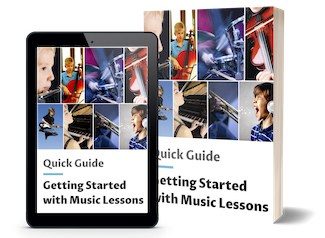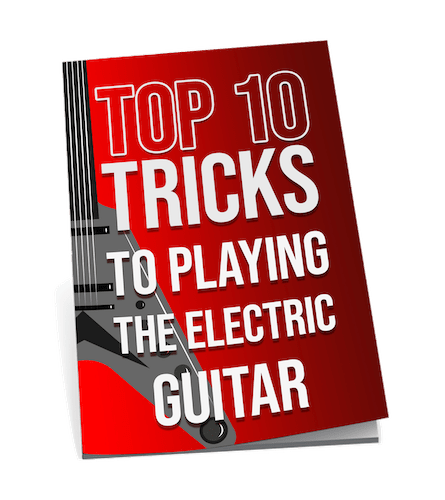Learning rock guitar is one of the most exciting musical journeys you can start, but picking the right beginner guitar can feel overwhelming with so many options out there. The Ibanez RG421 stands out as the best beginner rock guitar because it offers the fast neck, powerful humbuckers, and solid build quality that rock music demands at a price that won’t break the bank.
I’ve spent years helping new guitarists find their perfect first instrument, and I know how important it is to get something that sounds great and feels comfortable to play. The right guitar will keep you motivated to practice, while the wrong one might end up collecting dust in a corner.
In this guide, I’ll walk you through everything you need to know about choosing your first rock guitar, from understanding different pickup types to comparing the essential features that matter most. We’ll explore the top beginner-friendly options and cover all the gear you’ll need to start rocking out right away.
Key Features of a Great Beginner Rock Guitar

Choosing your first electric guitar involves understanding several key features that directly impact your playing experience. The body shape affects comfort, neck profile determines how easily you can move around the fretboard, pickups shape your sound, and hardware affects tuning stability.
Body Shape and Size
I always recommend starting with a comfortable body shape that won’t strain your arms or torso during practice sessions. The classic Stratocaster and Les Paul shapes are popular for good reasons – they balance well and feel natural against your body.
Stratocaster-style guitars feature lightweight bodies with comfortable contours. These guitars typically weigh less than Les Paul styles, making them easier for beginners to handle during long practice sessions.
Les Paul-style guitars offer a thicker, more substantial feel. They provide excellent sustain for rock music but can be heavier on your shoulder.
Here’s what I consider when evaluating body size:
- Weight: Lighter guitars reduce shoulder fatigue
- Thickness: Thinner bodies feel more comfortable for smaller players
- Cutaways: Double cutaways provide better access to high frets
The body wood affects tone, but as a beginner, comfort should be your priority. A guitar that feels good in your hands encourages more practice time.
Neck Profile and Playability
The neck profile dramatically affects how easily you can form chords and play melodies. I prefer C-shaped necks for beginners because they fit most hand sizes comfortably.
Neck thickness varies between “slim” and “chunky” profiles. Slim necks work well for players with smaller hands, while some prefer the substantial feel of thicker necks.
Fretboard radius influences string bending and chord playing:
| Radius | Best For | Feel |
|---|---|---|
| 9.5" | Chords | Comfortable |
| 12" | Mixed playing | Balanced |
| 16" | Lead guitar | Flat |
The scale length affects string tension and fret spacing. Most beginner guitars use a 25.5″ scale length, which provides good string tension for rock playing.
Fret size matters too – medium jumbo frets offer the best balance between chord work and string bending for rock music.
Pickup Types and Configuration
Pickups are the heart of your electric guitar’s sound. I recommend understanding the differences between humbucker pickups and single-coil pickups before making your choice.
Humbucker pickups produce a thicker, warmer tone that’s perfect for rock music. They handle distortion well and reduce unwanted noise, making them ideal for beginners who want that classic rock sound.
Single-coil pickups deliver a brighter, more cutting tone. They’re great for clean sounds and lighter rock styles but can pick up electrical interference.
Common pickup configurations include:
- HSS: Humbucker in bridge, single-coils in middle and neck positions
- HH: Two humbuckers for maximum rock power
- SSS: Three single-coils for versatile clean and light rock tones
For rock music, I prefer guitars with at least one humbucker in the bridge position. This gives you access to powerful, saturated tones when using distortion.
Bridge and Hardware Considerations
The bridge system affects tuning stability and playability significantly. I always recommend fixed bridges for beginners because they stay in tune better and require less maintenance.
Fixed bridge guitars offer excellent tuning stability and easier string changes. They’re perfect for learning basic techniques without worrying about complex setup issues.
Tremolo bar systems add vibrato effects but require more setup knowledge. While they’re fun for experienced players, they can frustrate beginners with tuning problems.
Key hardware features to consider:
- Tuning machines: Look for sealed tuners that hold pitch well
- Nut material: Synthetic materials work fine for beginners
- Bridge posts: Quality metal hardware improves sustain
I suggest avoiding guitars with floating tremolo systems until you’re comfortable with basic maintenance. These systems require precise setup and can go out of tune easily if not properly maintained.
Quality hardware doesn’t need to be expensive, but it should feel solid and operate smoothly when you test the guitar.
Top Beginner Electric Guitars for Rock

These four electric guitars offer the best combination of rock tone, playability, and value for new players. Each model provides distinct advantages for beginners who want to master rock music fundamentals.
Yamaha Pacifica 112V and 112
I’ve always been impressed by how the Yamaha Pacifica 112V punches above its weight class. This guitar gives you serious rock tone without breaking the bank.
The HSS pickup configuration is perfect for rock beginners. You get two single-coils for crisp rhythm work and a humbucker for chunky power chords.
Key Features:
- Alder body with solid construction
- HSS pickup layout (2 single-coils + 1 humbucker)
- 5-way pickup selector
- Coil-split function on tone knob
The maple neck has a comfortable C-shape that makes barre chords easier to play. I found the 22-fret rosewood fingerboard smooth and fast for lead work.
At around $340, the Pacifica 112V offers incredible value. The build quality rivals guitars costing twice as much.
The regular Pacifica 112 is also solid but lacks the coil-splitting feature. For rock beginners, I recommend spending the extra money on the 112V model.
This guitar handles everything from classic rock to modern metal. The versatility means you won’t outgrow it quickly as your skills develop.
Yamaha Pacifica 112V, Black
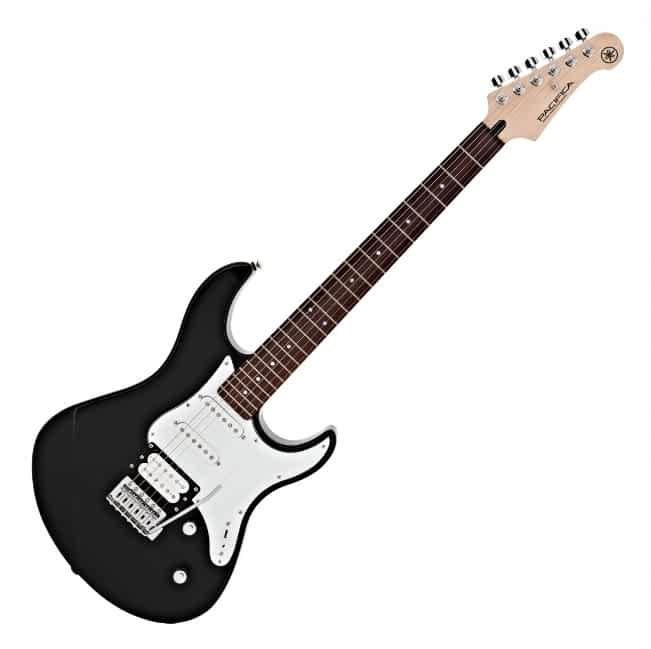
PERFECT FOR: Beginner guitarists
FEATURES: Made of Alder
OTHER INFO: Includes a vintage tremolo system for expressive playing
- Excellent build quality
- Highly versatile
- Lightweight and comfortable body
- Volume and tone knobs for customizing sound
- Cheap body material
- Lacks personality
When you click ‘Check Price’, you’ll see there are loads of great places to buy this item. Our personal favorite is Sweetwater for the US, and Thomann and Gear4Music for the UK & Europe.
They are the largest music retailers, with excellent customer service, competitive prices, really fast shipping, and the longest guarantees.
The professional musician who wrote this article combined many things,
from the product build, manufacturer’s reputation through to feedback
from other users, to create our famous TedScore™.
Squier Affinity Series Stratocaster
The Squier Affinity Series Stratocaster brings classic Fender tone to budget-conscious rock beginners. I love how this guitar captures the essence of rock history.
This Stratocaster features three single-coil pickups that deliver bright, cutting tones. The bridge pickup especially shines for rock rhythm playing.
Specifications at a Glance:
| Feature | Details |
|---|---|
| Body | Poplar |
| Neck | Maple with "C" shape |
| Pickups | 3 single-coil ceramic |
| Price Range | $180-220 |
The tremolo bridge lets you add vibrato effects to your playing. While not as stable as fixed bridges, it’s great for learning classic rock techniques.
I appreciate the thin neck profile that makes chord changes smoother. New players find this especially helpful when learning complex rock progressions.
The ceramic pickups sound bright and clear through rock amps. They handle distortion well without getting muddy or unclear.
For under $200, you get authentic Stratocaster DNA. This makes it one of the best beginner electric guitars for rock on a tight budget.
Squier Affinity Stratocaster HSS Pack, Lake Placid Blue

FEATURES: Humbucker-single-single pickups for versatile sound range
OTHER INFO: Includes amp, cable, strap, picks, and online lessons, making it a complete starter kit
- Durable build with classic Stratocaster design
- Offers diverse sound options for various genres
- Complete package for beginners to get started
- Basic amp limits tone quality for advanced players
- May require setup adjustments out of the box
When you click ‘Check Price’, you’ll see there are loads of great places to buy this item. Our personal favorite is Sweetwater for the US, and Thomann and Gear4Music for the UK & Europe.
They are the largest music retailers, with excellent customer service, competitive prices, really fast shipping, and the longest guarantees.
The professional musician who wrote this article combined many things,
from the product build, manufacturer’s reputation through to feedback
from other users, to create our famous TedScore™.
Epiphone Les Paul Special II
The Epiphone Les Paul Special II gives you that legendary Les Paul rock sound at an entry-level price. I think it’s hard to beat for pure rock attitude.
This guitar features two humbucker pickups that deliver thick, powerful tones. The neck pickup sounds warm for solos while the bridge pickup cuts through any mix.
The mahogany body provides natural sustain that rock music demands. Single-note lines sing with rich harmonics and smooth decay.
Rock-Ready Features:
- Dual humbucker configuration
- Mahogany body and neck
- Tune-o-matic bridge
- 22-fret fingerboard
I find the neck slightly chunkier than modern guitars but very comfortable. The weight distribution feels balanced whether sitting or standing.
At around $200, this Les Paul offers serious rock credibility. You’re getting the classic Gibson body shape and pickup layout.
The hardware is basic but functional for beginners. The tuners hold pitch well and the bridge provides good sustain and intonation.
This guitar excels at classic rock, hard rock, and metal styles. If you want that thick, creamy Les Paul tone, this is your best budget option.
Epiphone Les Paul Special, TV Yellow
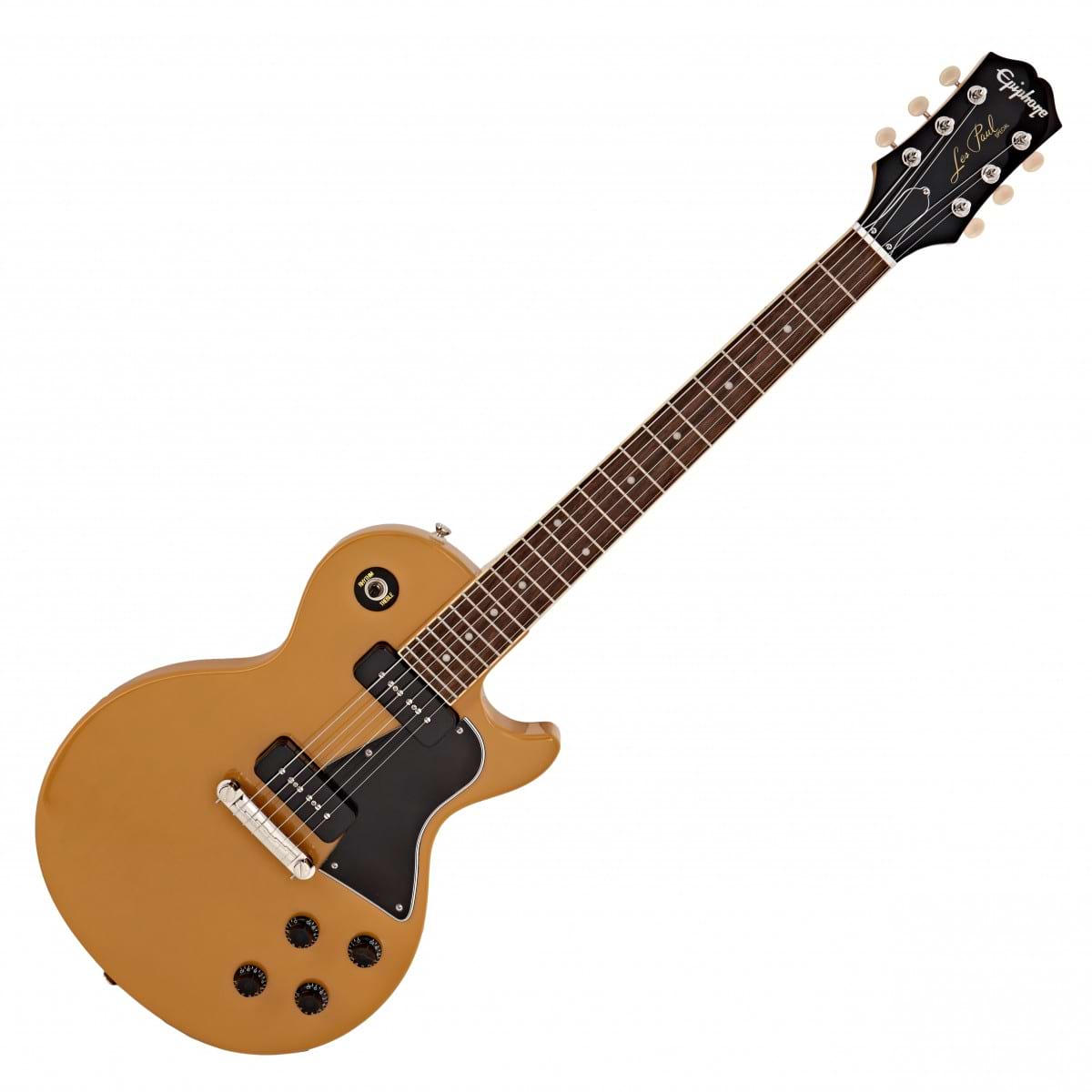
PERFECT FOR: Intermediate to advanced guitarists who love that iconic Les Paul sound with a modern twist
FEATURES: Dual P-90 PRO single-coil pickups for punchy, vintage tone
OTHER INFO: Features a mahogany body and neck, 22 medium jumbo frets, and a smooth TV Yellow satin finish that pays homage to 1950s style.
- Warm, rich tone with classic P-90 bite
- Lightweight and comfortable to play
- Retro aesthetic with solid build quality
- Limited tonal range compared to more expensive Les Paul models
When you click ‘Check Price’, you’ll see there are loads of great places to buy this item. Our personal favorite is Sweetwater for the US, and Thomann and Gear4Music for the UK & Europe.
They are the largest music retailers, with excellent customer service, competitive prices, really fast shipping, and the longest guarantees.
The professional musician who wrote this article combined many things,
from the product build, manufacturer’s reputation through to feedback
from other users, to create our famous TedScore™.
Fender Player Series
The Fender Player Series represents a step up in quality for serious rock beginners. I consider these guitars the sweet spot between affordability and professional features.
These guitars feature upgraded pickups and hardware compared to entry-level models. The build quality feels solid and reliable for regular gigging.
The Player Series Stratocaster offers three Player Series Alnico pickups. These sound fuller and more dynamic than ceramic pickups found on cheaper guitars.
Player Series Advantages:
- Alnico pickup magnets
- Modern “C” neck shape
- 22-fret fingerboard
- 2-point tremolo bridge
I love the modern tremolo design that stays in tune better than vintage-style bridges. This makes it perfect for rock players who use vibrato effects.
The neck feels fast and comfortable across all 22 frets. The satin finish on the back prevents stickiness during long practice sessions.
At $800-900, these guitars cost more than true beginner models. However, the quality jump is significant and worth the investment.
You won’t need to upgrade this guitar as your skills improve. It’s professional enough for recording and live performance from day one.
Fender Player Telecaster MN, Black
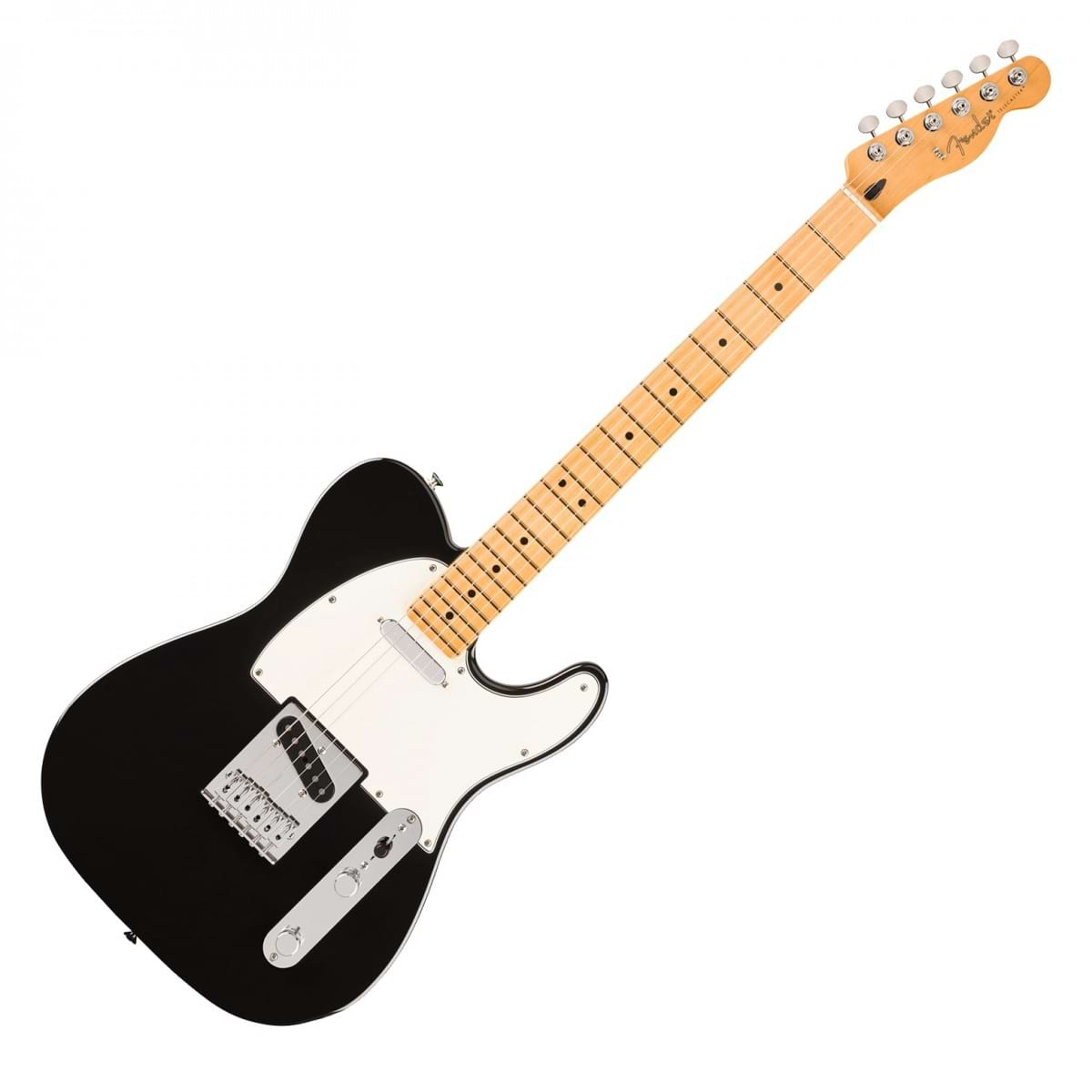
FEATURES: .009-.042 Gauges)
OTHER INFO: Player Series Alnico 5 Tele Single-Coil pickups
- Well-balanced bridge pickup, excelling with gain.
- Highly playable satin-finished neck.
- High-quality construction.
- Pickups may exhibit noise in specific situations.
- Facing stiff competition from other Telecaster models in the same price range.
When you click ‘Check Price’, you’ll see there are loads of great places to buy this item. Our personal favorite is Sweetwater for the US, and Thomann and Gear4Music for the UK & Europe.
They are the largest music retailers, with excellent customer service, competitive prices, really fast shipping, and the longest guarantees.
The professional musician who wrote this article combined many things,
from the product build, manufacturer’s reputation through to feedback
from other users, to create our famous TedScore™.
Comparing Acoustic and Electric Guitars for Beginners

Electric guitars typically feel easier to play with thinner strings and slimmer necks, while acoustic guitars offer immediate playability without needing an amp. Each type has distinct advantages that suit different learning styles and musical goals.
Pros and Cons of Electric Guitars
Electric guitars make learning easier on your fingers. The thinner strings require less pressure to press down, which means less pain as you build calluses.
I love how electric guitar necks are usually slimmer. This makes it easier to wrap your hand around the neck and reach all the frets comfortably.
The solid body design feels more comfortable when sitting or standing. You won’t wrestle with a big, bulky guitar body like you might with an acoustic.
Electric Guitar Advantages:
- Thinner strings (.009-.011 gauge)
- Less finger pressure needed
- Slimmer neck profiles
- Ergonomic body shapes
- Volume control through amp
- Endless tone possibilities with effects
However, electric guitars need extra gear to work. You’ll need an amp, cable, and possibly effects pedals to get started.
The learning curve includes mastering volume levels and amp settings. This can feel overwhelming when you just want to play simple songs.
Electric guitars are also heavier than acoustics. Your shoulder might get tired during longer practice sessions.
Pros and Cons of Electric Guitars
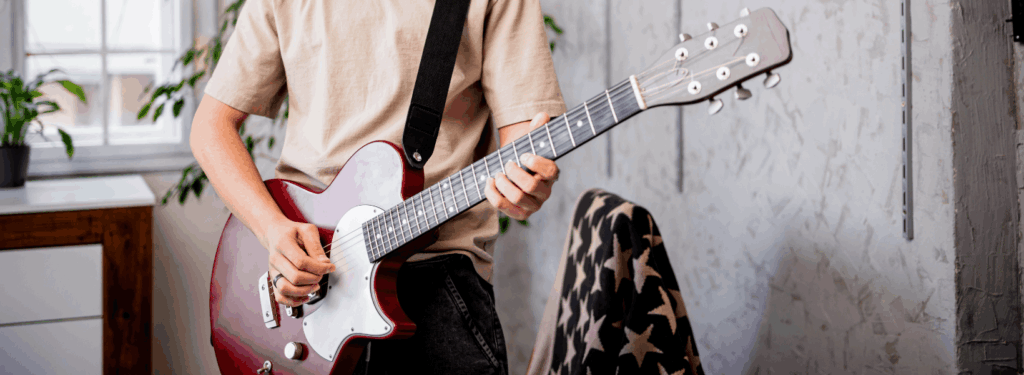
Acoustic guitars offer instant gratification – just pick one up and play. I appreciate how you don’t need electricity, amps, or cables to make music.
The portability factor is huge for beginners. You can practice anywhere, anytime, even during power outages.
Electric Guitar Advantages:
- No additional equipment needed
- Highly portable
- Natural, immediate sound
- Great for learning rhythm and strumming
- Builds finger strength faster
- Lower initial cost
The downside is that acoustic guitar strings are thicker (.011-.014 gauge). This means more tension and pressure needed to fret notes cleanly.
Your fingertips will hurt more initially with a beginner acoustic guitar. The thicker strings and higher action can be tough on uncalloused fingers.
Acoustic guitars have larger bodies that some beginners find awkward. The neck is often thicker, making chord shapes harder to form at first.
Transitioning from Acoustic to Electric
Moving from acoustic to electric feels like switching from a workout bike to a regular bike. Everything suddenly feels lighter and more responsive under your fingers.
The thinner strings on electric guitars will feel almost effortless after acoustic training. Bending strings and playing fast passages becomes much easier.
Key Transition Benefits:
- Improved finger dexterity from acoustic practice
- Stronger fretting hand from pressing thicker strings
- Better rhythm skills developed on acoustic
- Solid foundation in basic techniques
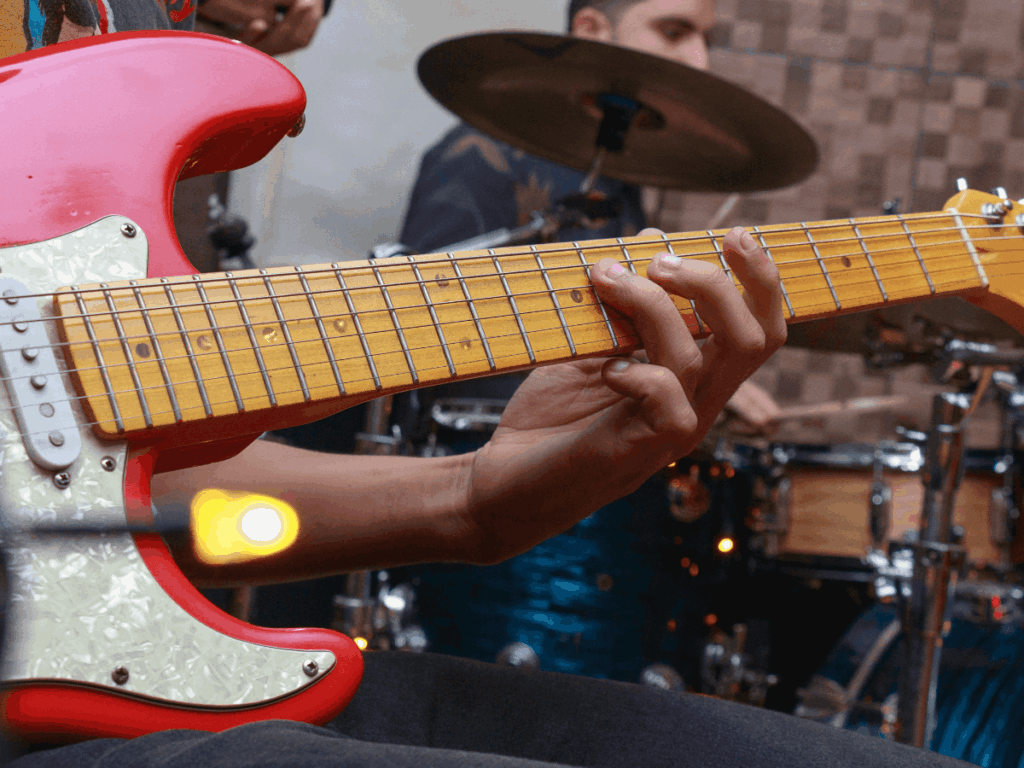
You’ll need to learn new skills like amp controls and effects. Start with a simple practice amp that has basic clean and distortion settings.
Your picking technique might need adjustment too. Electric guitars respond to lighter touches, so you won’t need to strum as hard as you did on acoustic.
The transition usually takes just a few practice sessions. Most players find electric guitars more forgiving and easier to play after acoustic experience.
Understanding Pickups: Humbuckers vs Single-Coils
The pickup you choose will shape your entire rock sound experience. Humbuckers deliver thick, powerful tones perfect for heavy rock, while single-coils provide bright, cutting sounds ideal for classic rock styles.
Sound Differences in Rock Genres
I’ve found that humbuckers excel at delivering the chunky, saturated tones that make hard rock and metal sing. Their dual-coil design cancels out electrical hum while pumping out higher output levels.
When I crank up the gain, humbuckers maintain clarity even with heavy distortion. They produce warm, full-bodied sounds that cut through dense mix arrangements.
Single-coil pickups shine in classic rock, blues rock, and punk genres. Their bright, articulate tone gives you that iconic bite and sparkle.
I love how single-coils respond to my picking dynamics – they clean up beautifully when I play softly. However, they can pick up electrical interference, creating that characteristic 60Hz hum.
Genre Breakdown:
- Hard Rock/Metal: Humbuckers dominate
- Classic Rock: Both work great
- Blues Rock: Single-coils preferred
- Punk Rock: Single-coils provide aggression
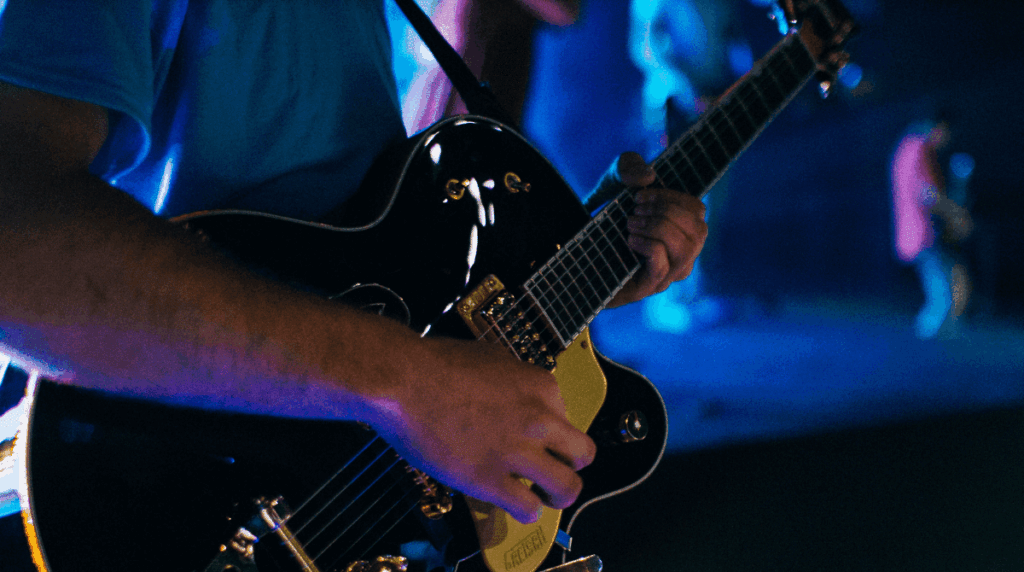
Famous Rock Guitars and Pickup Types
Les Paul
Stratocaster
Telecaster
Best Pickup Configurations for Beginners
I recommend starting with a humbucker-equipped guitar if you’re drawn to heavier rock styles. You’ll get that thick, forgiving tone that sounds great even through budget amps.
A single-coil Stratocaster offers the most versatility for exploring different rock subgenres. Its three-pickup layout teaches you how pickup positions affect your sound.
HSS (Humbucker-Single-Single) configuration gives you the best of both worlds. I can switch between chunky rhythm tones and bright, cutting leads on the same guitar.
Consider these starter-friendly options:
| Configuration | Best For | Advantages |
|---|---|---|
| Dual Humbuckers | Hard rock, metal | High output, less noise |
| Triple Single-Coil | Classic rock, blues | Maximum versatility |
| HSS | All rock styles | Combines both pickup types |
My advice? Choose based on your favorite rock bands’ sounds rather than overthinking the technical details.
Essential Gear and Accessories for Starting Out
Getting your first rock guitar is just the beginning – you’ll need the right amplifier and key accessories to unlock your electric guitar’s full potential. Smart gear choices can make learning easier and more enjoyable while staying within budget.
Choosing the Right Amplifier
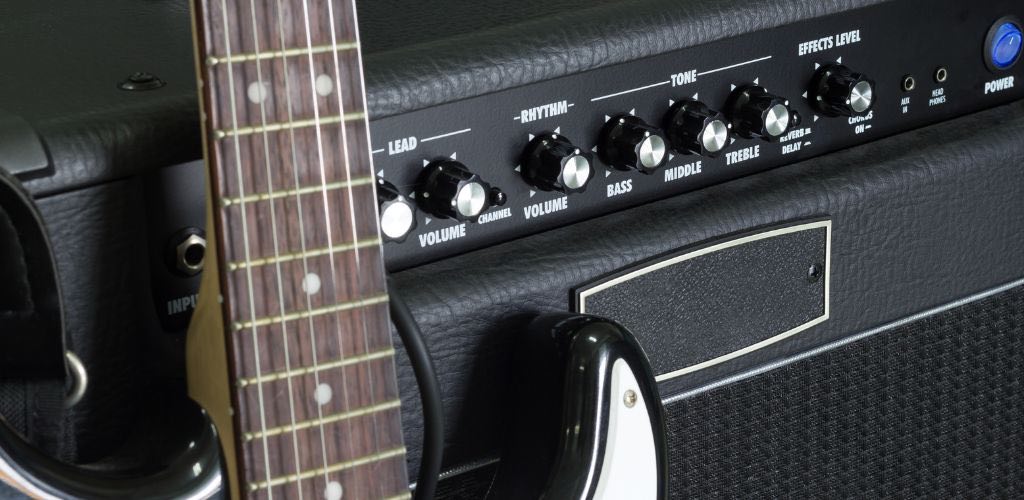
Your electric guitar needs an amp to truly come alive. Without one, you’re missing the power and tone that makes rock music exciting.
For bedroom practice, I recommend starting with a 10-15 watt amp. The Fender Champion 20 or Boss Katana-50 offer great rock tones without breaking the bank.
These amps include built-in effects like distortion and reverb. You won’t need extra pedals right away.
If you live in an apartment, consider a headphone amp like the Vox amPlug. It plugs directly into your guitar and lets you practice silently.
Practice amps typically cost between $50-150. Don’t spend more than your guitar’s value on your first amp.
Look for amps with multiple channels – clean and drive settings. This lets you switch between mellow and aggressive rock tones instantly.
Must-Have Accessories for Beginners
Every new guitarist needs these four essential items from day one. Guitar picks are absolutely necessary – start with medium thickness picks from Dunlop or Fender.
A guitar tuner keeps you sounding good during practice. Clip-on tuners like the Korg Pitchclip attach to your headstock and work perfectly.
Extra strings will save you when one breaks unexpectedly. D’Addario and Ernie Ball make reliable sets that cost around $5-8.
For electric guitars, you need a guitar cable to connect to your amp. Planet Waves cables offer good quality without the premium price.
A guitar strap lets you play standing up like rock stars do. Ernie Ball straps are comfortable and secure for under $10.
Consider getting a guitar stand to keep your instrument safe. Hercules makes sturdy stands that won’t let your guitar fall over.
Beginner-Friendly Guitar Bundles
Guitar bundles include everything you need in one purchase. They’re perfect for beginners who want convenience and value.
Most electric guitar starter packs include the guitar, amp, cable, picks, and strap. Brands like Squier, Epiphone, and Yamaha offer quality bundles under $300.
The Squier Stratocaster Pack includes a classic rock guitar with a 15-watt amp. Everything connects together so you can start playing immediately.
Epiphone Les Paul bundles give you that thick rock tone Gibson is famous for. The included amp has built-in distortion perfect for learning rock songs.
These bundles cost 20-30% less than buying items separately. You also know everything will work together from the start.
Some bundles include extras like a gig bag, tuner, or instructional materials. Check what’s included before buying to avoid duplicate purchases.
Tips for Making the Right Choice as a Beginner
Setting a realistic budget and understanding how different shopping methods affect your purchase will save you money and frustration. The guitar’s setup quality can make or break your learning experience.
Deciding on a Budget
I recommend setting aside $200-500 for your first guitar and amplifier combo. This range gets you a quality beginner guitar that won’t fight against you while learning.
Don’t go too cheap with guitars under $150. These often have poor intonation and high action that makes playing harder than it should be.
Consider these budget ranges for best beginner electric guitars:
- $200-300: Squier Stratocaster, Epiphone Les Paul Special
- $300-400: Yamaha Pacifica, higher-end Squier models
- $400-500: Epiphone Standard series, Mexican Fender alternatives
Remember to budget for an amplifier too. A small 10-15 watt practice amp costs $50-100 and is essential for electric guitars.
Buy used guitars from reputable sellers to stretch your budget further. Many guitar for beginners options are available in excellent used condition.
Trying Guitars In-Person vs Online
I strongly suggest trying guitars in person when possible. Your hands and body are unique, and what feels comfortable varies from person to person.
Visit local music stores and hold different beginner guitar models. Pay attention to neck thickness, body weight, and how the guitar sits against your body.
Online shopping offers better prices and selection. However, you risk getting a guitar that doesn’t feel right in your hands.
In-person benefits
Test comfort and playability
Hear the actual sound
Get expert advice from staff
Immediate gratification
Online benefits
Better prices and deals
Larger selection
Customer reviews
Easy returns (usually)
If buying online, choose retailers with good return policies. Most major music stores offer 30-45 day return windows for guitars.
Importance of Setup and Playability
A proper guitar setup makes learning dramatically easier. Poor setup causes buzzing strings, difficult bending, and finger fatigue.
Check these setup elements when trying guitars:
- String height (action should be low but not buzzing)
- Neck straightness (slight relief prevents buzzing)
- Intonation (12th fret harmonic matches fretted note)
Many new guitars need setup work from the factory. Budget an extra $50-75 for professional setup if needed.
Ask the store if setup is included with your purchase. Many shops offer free basic setup with guitar sales.
Look for guitars that play smoothly up and down the neck. If you struggle to press strings down, the action is probably too high.
A well-set-up budget guitar will always play better than an expensive guitar with poor setup. This is especially important for beginners who are still building finger strength.
FAQ's
I always tell new players to focus on comfort first. Look for a guitar with a lightweight body and smooth neck that feels good in your hands.
Humbucker pickups are perfect for rock music. They give you that thick, warm sound that works great with distortion.
Check the action on the guitar too. Lower action means the strings sit closer to the frets, making it easier to press down and play chords.
A simple control layout helps when you’re learning. Two or three knobs are plenty for adjusting your sound without getting confused.
Squier by Fender makes excellent starter guitars that won’t break your budget. Their Affinity Stratocaster models are perfect for rock music.
Epiphone offers great Les Paul-style guitars for beginners. The Les Paul Special II gives you that classic rock sound at a friendly price.
Yamaha’s Pacifica series is another solid choice. These guitars are known for their quality and versatility across different rock styles.
Ibanez makes beginner guitars with fast necks that many rock players love. The GRX series offers great value for new guitarists.
Beginner guitars focus on playability and affordability over premium materials. They use simpler electronics and hardware to keep costs down.
Advanced guitars feature high-end woods and precision craftsmanship. The pickups and hardware are usually much more expensive and refined.
The setup on beginner guitars might not be as precise. But this doesn’t mean they sound bad or are hard to play when set up properly.
Professional guitars often have more tonal options and switches. Beginners benefit from simpler controls while they’re learning the basics.
Body style affects both comfort and sound in ways that matter to new players. A lighter guitar reduces fatigue during long practice sessions.
Double-cutaway designs like Stratocasters give you easier access to higher frets. This helps when you start learning lead guitar techniques.
Les Paul-style guitars have a thicker, warmer tone that’s great for heavy rock. But they’re heavier, which might tire out smaller players faster.
The most important thing is that the guitar feels comfortable when you hold it. Try different body styles to see what works best for you.
The Squier Affinity Stratocaster HSS is my top pick for rock beginners. It has both single-coil and humbucker pickups for versatile sounds.
Epiphone Les Paul Special II delivers classic rock tones at a great price. The dual humbuckers are perfect for power chords and distorted sounds.
Yamaha Pacifica PAC112V offers excellent build quality and versatility. It’s a bit more expensive but worth the investment for serious beginners.
Dean ML 79 brings that edgy rock look with solid performance. It’s perfect if you want to look like a rock star while learning.
An amplifier is absolutely essential since electric guitars need one to be heard properly. Small practice amps work great for beginners.
Get a guitar cable to connect your guitar to the amp. A standard 1/4 inch instrument cable is what you need.
Guitar picks are cheap but necessary for rock playing. Start with medium thickness picks for the best balance of control and tone.
A guitar strap lets you play standing up like a real rock star. It also helps support the weight of the guitar while sitting.
Consider a beginner guitar method book or online lessons. Having structured learning materials will help you progress much faster.




